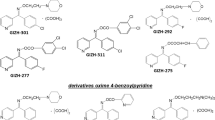Abstract
The behavioural and electrocorticographic (ECoG) convulsant effects of several xanthine derivatives injected intraperitoneally (i.p.) were studied in genetically-epilepsy prone rats. The aim of the study was to evaluate the relationship among convulsant potency, molecular structure and lipophilicity of some xanthines. Animals were injected i.p. with various doses (250-1000 mmol/kg) and a different convulsant potency was observed among the various xanthines tested. IBMX (3-isobutyl-1-methylxanthine), theophylline (1,3-dimethylxanthine) and caffeine (1,3,7-trimethylxanthine) induced an epileptogenic pattern that consisted in an initial phase characterized by wet-dog shakes followed by head tremor, nodding, clonic convulsion and they appeared to be the most potent xanthines among those studied. During seizures, the electrocortical activity was usually characterized by single or multiple sharp- or spike-wave episodes followed by polyspike discharges. After the highest doses of IBMX, theophylline and caffeine, the animals react with falling down, transient tonic clonic seizures, escape response and generalized seizures followed by post-ictal period. Equimolar doses of 8-chlorotheophylline and theobromine (3,7-dimethylxanthine) produced less evident epileptic responses in comparison to previous compounds, whereas no epileptic signs were observed following the administration of enprofylline (3-propylxanthine), etofylline [7-(2-hydroxyethyl)theo-phylline], diprophylline [7-(2,3-dihydroxy-propyl)theo-phylline] and doxofylline [7-(1,3-dioxolan-2-ylmethyl) theophylline]. Lipophylicity of the compounds was determined, but no convincing correlations were found between the rank order of lipophilicities and the convulsant potencies of the compounds studied. On the other hand, structure-activity relationship was also investigated. We suggest that the substitution pattern on the xanthine nucleus may explain, in part, the different convulsant potency of the compounds studied. Furthermore, a selective antagonism of adenosine subtype receptors should be considered.
Similar content being viewed by others
Author information
Authors and Affiliations
Additional information
Received: 19 April 1996 / Accepted: 18 March 1997
Rights and permissions
About this article
Cite this article
Sarro, A., Grasso, S., Zappalà, M. et al. Convulsant effects of some xanthine derivatives in genetically epilepsy-prone rats. Naunyn-Schmiedeberg's Arch Pharmacol 356, 48–55 (1997). https://doi.org/10.1007/PL00005027
Issue Date:
DOI: https://doi.org/10.1007/PL00005027



